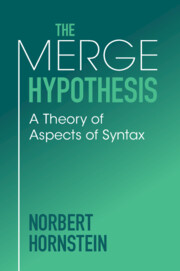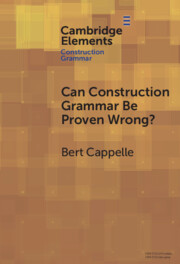Refine search
Actions for selected content:
6584 results in Grammar and Syntax
8 - Odds and Ends
-
- Book:
- The Merge Hypothesis
- Published online:
- 15 February 2024
- Print publication:
- 22 February 2024, pp 207-229
-
- Chapter
- Export citation
1 - A Whig History of Generative Grammar
-
- Book:
- The Merge Hypothesis
- Published online:
- 15 February 2024
- Print publication:
- 22 February 2024, pp 13-46
-
- Chapter
- Export citation
Introduction
-
- Book:
- The Merge Hypothesis
- Published online:
- 15 February 2024
- Print publication:
- 22 February 2024, pp 1-12
-
- Chapter
- Export citation
2 - Tools and Particulars
-
- Book:
- The Merge Hypothesis
- Published online:
- 15 February 2024
- Print publication:
- 22 February 2024, pp 47-74
-
- Chapter
- Export citation
9 - Conclusion
-
- Book:
- The Merge Hypothesis
- Published online:
- 15 February 2024
- Print publication:
- 22 February 2024, pp 230-233
-
- Chapter
- Export citation

The Merge Hypothesis
- A Theory of Aspects of Syntax
-
- Published online:
- 15 February 2024
- Print publication:
- 22 February 2024

Can Construction Grammar Be Proven Wrong?
-
- Published online:
- 05 January 2024
- Print publication:
- 01 February 2024
-
- Element
- Export citation

Copilots for Linguists
- AI, Constructions, and Frames
-
- Published online:
- 20 December 2023
- Print publication:
- 01 February 2024
-
- Element
- Export citation
2 - Languages of Europe
-
- Book:
- Languages of the World
- Published online:
- 21 November 2023
- Print publication:
- 07 December 2023, pp 43-76
-
- Chapter
- Export citation
4 - Languages of Northern Eurasia
-
- Book:
- Languages of the World
- Published online:
- 21 November 2023
- Print publication:
- 07 December 2023, pp 109-147
-
- Chapter
- Export citation
Index of Languages
-
- Book:
- Languages of the World
- Published online:
- 21 November 2023
- Print publication:
- 07 December 2023, pp 477-486
-
- Chapter
- Export citation
Dedication
-
- Book:
- Languages of the World
- Published online:
- 21 November 2023
- Print publication:
- 07 December 2023, pp v-vi
-
- Chapter
- Export citation
5 - Languages of the Caucasus
-
- Book:
- Languages of the World
- Published online:
- 21 November 2023
- Print publication:
- 07 December 2023, pp 148-187
-
- Chapter
- Export citation
Acknowledgments
-
- Book:
- Languages of the World
- Published online:
- 21 November 2023
- Print publication:
- 07 December 2023, pp xvi-xvi
-
- Chapter
- Export citation
Fascinating Language Topics
-
- Book:
- Languages of the World
- Published online:
- 21 November 2023
- Print publication:
- 07 December 2023, pp xv-xv
-
- Chapter
- Export citation
11 - Indigenous Languages of Canada and the USA
-
- Book:
- Languages of the World
- Published online:
- 21 November 2023
- Print publication:
- 07 December 2023, pp 371-404
-
- Chapter
- Export citation
References
-
- Book:
- Languages of the World
- Published online:
- 21 November 2023
- Print publication:
- 07 December 2023, pp 455-476
-
- Chapter
- Export citation
Reviews
-
- Book:
- Languages of the World
- Published online:
- 21 November 2023
- Print publication:
- 07 December 2023, pp ii-ii
-
- Chapter
- Export citation
7 - Languages of Sub-Saharan Africa
-
- Book:
- Languages of the World
- Published online:
- 21 November 2023
- Print publication:
- 07 December 2023, pp 226-257
-
- Chapter
- Export citation
9 - Languages of the Pacific
-
- Book:
- Languages of the World
- Published online:
- 21 November 2023
- Print publication:
- 07 December 2023, pp 296-334
-
- Chapter
- Export citation
